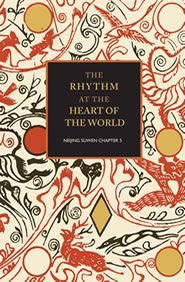We use cookies to make your experience better. To comply with the new e-Privacy directive, we need to ask for your consent to set the cookies. Learn more.
The Rhythm at the Heart of the World
Chinese medical knowledge is based on an understanding of the processes of yin yang and the five elements. Chapter five of the Neijing Suwen, the first part of the Yellow Emperor’s Inner Classic, lays out these principles. The chapter begins with the laws of yin yang, progresses to the resonances of the five elements within the human body, and culminates with detailed descriptions of medical pathology.
The Neijing Suwen (Yellow Emperor's Inner Classic, Basic Questions) is a much-quoted text that holds special importance for practitioners of Chinese medicine. Elisabeth Rochat de la Vallée's most recent publication is a translation of Suwen Chapter 5, which discusses the concepts and pathologies of yinyang and the five phases. The title - 'The Rhythm at the Heart of the World' - refers to primordial yinyang and its fundamental place at the centre of the workings of the universe. The inception of yinyang from the original qi is the first manifestation of life, from which comes heaven and earth, and it is from the reciprocal relationship of heaven and earth that the ten thousand beings come into being. As a concept the 'ten thousand beings' make up and define all that exists in the universe: beings, phenomena, the organisation of life and the relationships and interactions that exist between these. Thus our understanding of this complex and subtle system and each part of it can be understood through considering the nature of yinyang. Beyond primal yinyang are the five phases, which describe the modes of action of qi in a way that furthers and makes concrete our understanding of the universe and each other. The medical aspects of yinyang and the five phases are codified in Chapter 5, providing us with a blueprint for understanding the fundamental workings, patterns and interactions of human life and the human body.
The importance of this text is that it illuminates the most fundamental aspects of Chinese medical theory. The translation is in two parts; first the text itself, with a direct translation opposite, followed by thorough explanations of the text. Each explanation includes the original Chinese characters, the pinyin and the English. It is here that the author excels; direct translations are often challenging to grasp and I could not imagine getting such a deep understanding of the text without these comprehensive and clear explanations. There is a lot of relevant information here; some of it of obvious and immediate clinical use, all of it relevant in terms of it adding substantially to our understanding of Chinese thought and medical practice.
The Chinese medical classics are fundamental to acupuncture practice; once we are reasonably and safely adept at the mechanics of clinical practice – point location, needling, moxa and so on – the classics give access to the essence of Chinese medicine. This is why translations like this are relevant and important. In the first few lines the text states, 'To treat disease one has to go to the root.' - a familiar truth that is easily understood, but the author's explanation brings new insight: 'To return to the root means to return to the patient's yinyang, and through this to the spirits where all the deviations from the natural movement originate.' Such depth of understanding is what makes this considered and expert translation essential reading for the practitioner. While some may consider such texts to be of value only to philosophers and theorists, my conviction is that they offer a practical foundation for clinical practice and serve as a reminder of the fundamental concepts of Chinese medicine.
Bruce McCallum
| Author | Elisabeth Rochat de la Vallee |
|---|---|
| Publication Date | 1 Jan 1970 |
| Publisher | Monkey Press |
| Number of Pages | 144 |
| Book Format | Paperback |
* Orders shipped outside of Europe are eligible for VAT relief and will not be charged VAT.


